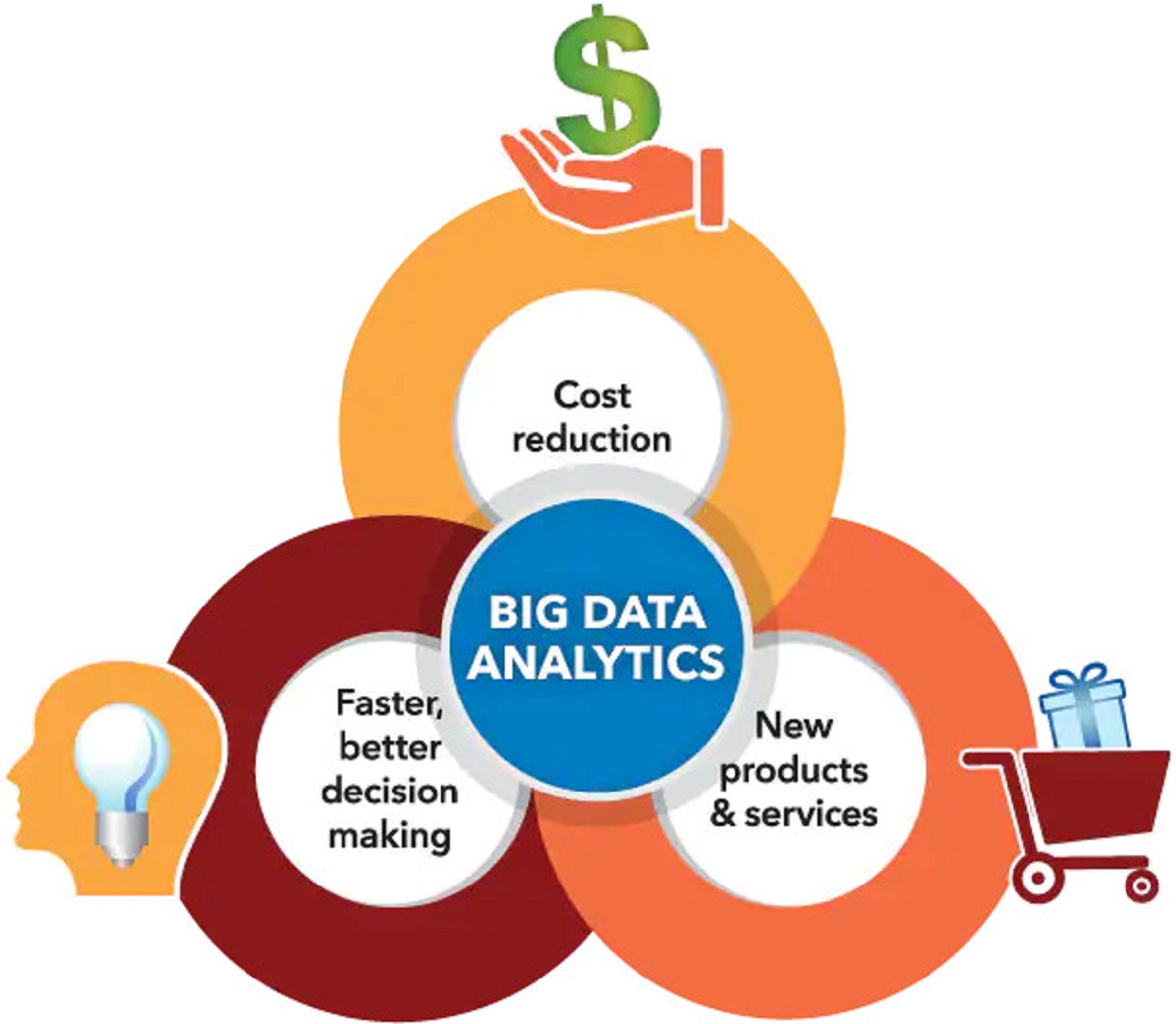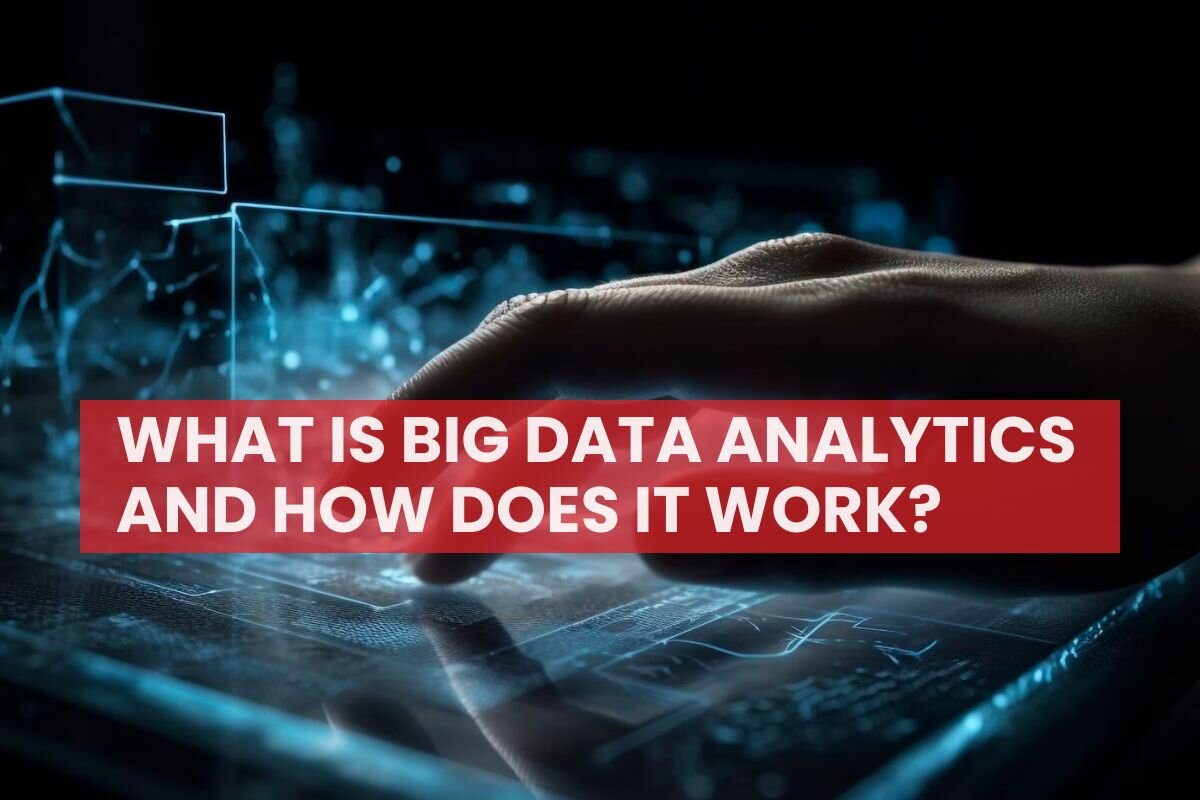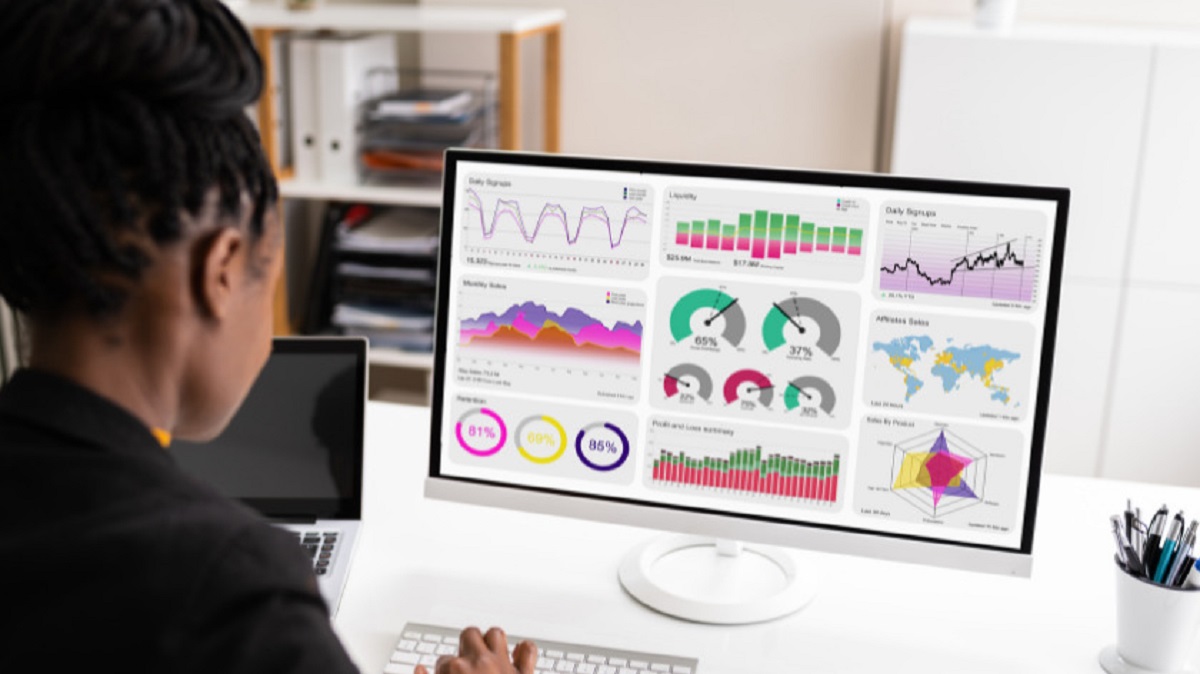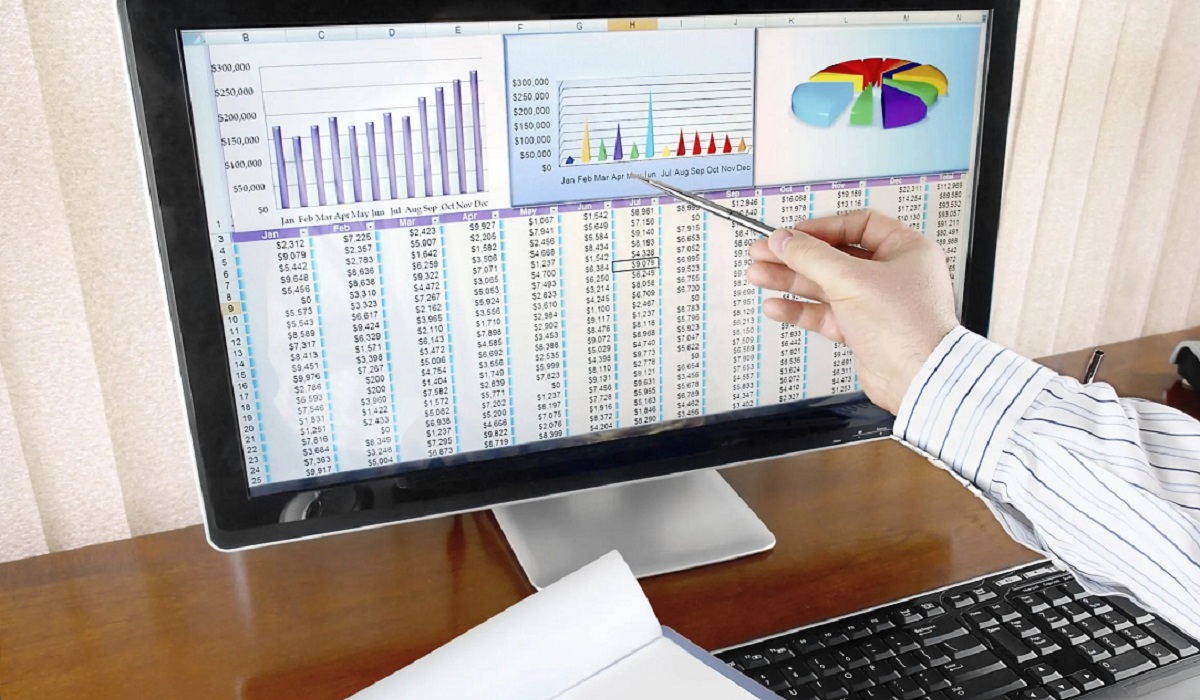Introduction
Welcome to the world of big data analytics, where vast amounts of data are transformed into meaningful insights and actionable strategies. In today’s digital era, businesses and organizations are generating enormous volumes of data at an unprecedented pace. This data, often referred to as big data, holds immense potential for unlocking valuable information and driving decision-making processes.
Big data analytics is the process of extracting, analyzing, and interpreting large and complex data sets with the goal of discovering patterns, trends, and correlations that can provide valuable business insights. It involves using sophisticated algorithms, statistical models, and data science techniques to uncover hidden patterns and derive actionable intelligence.
With the exponential growth of data from various sources such as social media, sensors, online transactions, and more, big data analytics has emerged as a crucial tool for businesses across industries. By harnessing the power of big data analytics, organizations can gain a competitive edge, make data-driven decisions, and improve operational efficiency.
The field of big data analytics encompasses a wide range of techniques and methodologies, including data mining, machine learning, predictive modeling, natural language processing, and more. These techniques allow organizations to delve deep into their data, extract meaningful insights, and make informed decisions for better business outcomes.
In this article, we will explore the importance of big data analytics, how it works, the different types of big data analytics, the challenges involved, and the benefits it offers. We will also delve into the tools and technologies that enable big data analytics and showcase real-world applications to understand its practical significance.
So, whether you are a business professional looking to leverage big data analytics for your organization or an individual curious about the world of data-driven insights, this article is here to guide you through the intricacies and potentials of big data analytics.
What is Big Data Analytics?
Big data analytics refers to the process of extracting and analyzing large and diverse datasets to uncover valuable insights, patterns, and trends. It involves the use of advanced technologies and techniques to manage, process, and interpret massive volumes of structured, semi-structured, and unstructured data.
The term “big data” refers to datasets that are too large and complex for traditional data processing applications to handle. These datasets typically have high velocity, variety, and veracity. Big data analytics helps organizations make sense of this overwhelming amount of data by employing specialized tools and algorithms that can handle the volume, velocity, variety, and veracity challenges associated with big data.
The goal of big data analytics is to transform raw data into meaningful and actionable insights that can drive informed decision-making and business strategies. By analyzing big data, organizations can gain a deeper understanding of their customers, identify market trends, optimize operations, mitigate risks, and improve overall business performance.
Big data analytics involves several stages to extract value from data. The first stage is data acquisition, where relevant data is collected from various sources such as social media platforms, customer transactions, sensors, and more. The acquired data is then stored in data warehouses or distributed file systems specifically designed to handle big data.
Next, the data is preprocessed to clean and transform it into a format suitable for analysis. This stage often involves data cleansing, integration, and normalization to ensure data quality and consistency. Once the data is prepared, it undergoes exploratory data analysis to identify patterns or correlations that can provide meaningful insights.
After exploratory analysis, organizations can apply various analytical techniques to extract insights from the data. This can include statistical analysis, data mining, machine learning, predictive modeling, natural language processing, and more. These techniques enable organizations to uncover hidden patterns, make predictions, and gain a holistic view of their data.
The final stage of big data analytics is the interpretation and visualization of the insights obtained from the analysis. Data visualization techniques, such as charts, graphs, and dashboards, help present the findings in a visually compelling and easily understandable format. This enables stakeholders at different levels of the organization to grasp the insights and make data-driven decisions accordingly.
In summary, big data analytics is a powerful discipline that enables organizations to unlock the potential of their data. By leveraging advanced technologies and methodologies, organizations can transform raw data into valuable insights, leading to improved decision-making, operational efficiencies, and ultimately, competitive advantage.
Why is Big Data Analytics Important?
Big data analytics plays a crucial role in today’s digital age, where data is considered the new currency. Here are several reasons why big data analytics is important:
1. Data-Driven Decision Making: Big data analytics provides organizations with valuable insights and information that can drive informed decision-making. By analyzing large datasets, organizations can gain a deeper understanding of customer behaviors, preferences, and needs, allowing them to tailor their strategies accordingly.
2. Improved Operational Efficiency: Big data analytics can help organizations identify inefficiencies and bottlenecks in their operations. By analyzing data from various sources, such as supply chain, manufacturing, and customer interactions, organizations can optimize processes, reduce costs, and improve overall efficiency.
3. Enhanced Customer Experience: Big data analytics enables organizations to understand their customers better. By analyzing customer data, organizations can personalize their marketing efforts, improve customer service, and offer customized products and services that meet individual needs and preferences.
4. Mitigating Risks: Big data analytics empowers organizations to identify potential risks and mitigate them proactively. By analyzing historical data and patterns, organizations can anticipate potential issues, fraud, or security threats, allowing them to take preventive measures and reduce risks.
5. Innovating Products and Services: Big data analytics can drive innovation by uncovering new insights and opportunities. By analyzing market trends, customer feedback, and competitor data, organizations can identify gaps in the market and develop innovative products and services to meet evolving customer demands.
6. Personalized Marketing: Big data analytics enables organizations to create targeted and personalized marketing campaigns. By analyzing customer preferences, behaviors, and demographics, organizations can segment their audience and deliver tailored messages, resulting in higher customer engagement and conversion rates.
7. Identifying Business Opportunities: Big data analytics helps organizations identify new business opportunities by analyzing market trends, social media chatter, and customer sentiment. By understanding emerging trends and customer demands, organizations can seize new opportunities and stay ahead of the competition.
8. Real-Time Insights: Big data analytics provides the ability to analyze and derive insights from data in real-time. This allows organizations to make instant decisions, respond to customer needs promptly, and adapt their strategies based on real-time market conditions.
9. Scalability and Flexibility: Big data analytics tools and technologies are designed to handle large and diverse datasets. They can scale seamlessly to accommodate growing data volumes and adapt to changing business requirements, ensuring organizations can continue to derive value from their data as it expands.
10. Competitive Advantage: Organizations that leverage big data analytics gain a competitive edge. By harnessing the power of data and turning it into actionable insights, organizations can make more informed decisions, deliver better products and services, and outperform competitors in the market.
In summary, big data analytics is essential for organizations looking to thrive in today’s data-centric world. By harnessing the power of data, organizations can gain valuable insights, drive operational efficiencies, enhance customer experiences, and unlock new opportunities, ultimately giving them a competitive advantage and ensuring long-term success.
How Does Big Data Analytics Work?
Big data analytics involves a complex process of acquiring, storing, processing, analyzing, and interpreting large and diverse datasets. Here is a simplified explanation of how big data analytics works:
1. Data Acquisition: The first step in big data analytics is to acquire the relevant data from various sources. This can include structured data from databases, unstructured data from social media platforms, log files, sensor data, and more. The data is collected and stored in data warehouses or distributed file systems designed to handle big data volumes.
2. Data Preparation: Once the data is acquired, it needs to be cleaned and preprocessed to ensure its quality and prepare it for analysis. This involves removing duplicates, handling missing values, and transforming the data into a consistent format. Data integration techniques are also applied to combine data from different sources, ensuring a unified view for analysis.
3. Exploratory Data Analysis: After data preparation, exploratory data analysis techniques are applied to gain an initial understanding of the data. This involves examining data distributions, identifying outliers, and visualizing the data to uncover patterns, correlations, and trends. Exploratory data analysis helps discover relationships and potential insights that can guide further analysis.
4. Applying Analytics Techniques: Once the data has been explored, various analytics techniques can be applied to extract valuable insights. This can include statistical analysis, data mining algorithms, machine learning models, natural language processing, and more. These techniques help identify patterns, predict outcomes, and uncover hidden insights that can inform decision-making.
5. Interpretation and Visualization: The insights obtained from the analysis need to be interpreted and presented in a meaningful way. Visualization techniques, such as charts, graphs, and dashboards, are used to communicate the findings effectively. Visualization makes it easier for stakeholders to understand complex data and make informed decisions based on the insights derived from the analysis.
6. Iterative Process: Big data analytics is often an iterative process, where insights from initial analysis inform further data exploration and refinement. As new data is acquired or as business needs change, the analysis process is repeated to continually uncover new insights and improve the accuracy and applicability of the findings.
7. Data Governance and Security: Data governance and security are essential aspects of big data analytics. Organizations need to implement measures to ensure data privacy, comply with regulations, and protect sensitive information. Safeguarding data integrity and maintaining data quality throughout the analytics process is crucial for reliable and trustworthy insights.
8. Scalable Infrastructure: Big data analytics requires a scalable infrastructure capable of handling the volume, velocity, and variety of big data. This involves utilizing distributed computing frameworks, such as Apache Hadoop or Apache Spark, which can process large datasets across multiple nodes in a distributed manner. Cloud-based solutions are also popular for their scalability and flexibility in accommodating growing data volumes.
In summary, big data analytics encompasses the entire process of acquiring, preparing, analyzing, interpreting, and visualizing large and diverse datasets. By leveraging sophisticated algorithms, statistical models, and visualization techniques, organizations can uncover valuable insights, make data-driven decisions, and derive business value from big data.
Types of Big Data Analytics
Big data analytics can be categorized into various types, each serving a distinct purpose and providing valuable insights. Here are some of the common types of big data analytics:
1. Descriptive Analytics: Descriptive analytics focuses on summarizing and visualizing historical data to understand what has happened in the past. It involves aggregating and analyzing data to provide insights into patterns, trends, and key performance indicators (KPIs). Descriptive analytics often uses visualization techniques to present data in a clear and understandable format.
2. Diagnostic Analytics: Diagnostic analytics goes a step beyond descriptive analytics by seeking to understand why certain events or outcomes occurred. It involves analyzing historical data and applying various techniques, such as root cause analysis and correlation analysis, to identify the factors that contributed to specific outcomes. Diagnostic analytics helps organizations gain deeper insights into the cause-effect relationships behind their data.
3. Predictive Analytics: Predictive analytics focuses on forecasting future outcomes based on historical data and patterns. It uses statistical modeling and machine learning algorithms to analyze historical data and identify trends and patterns that can be used to predict future events. Predictive analytics is valuable for organizations looking to make informed decisions and anticipate future trends and behaviors.
4. Prescriptive Analytics: Prescriptive analytics takes a step further by providing insights and recommendations on what actions to take based on the predicted outcomes. It considers various scenarios, constraints, and potential actions to identify the most optimal course of action. Prescriptive analytics helps organizations make data-driven decisions by providing actionable insights and recommendations.
5. Real-time Analytics: Real-time analytics focuses on analyzing data as it is generated in real-time. It involves processing high-velocity data streams and making immediate decisions based on the insights derived from the data. Real-time analytics is particularly valuable in applications such as fraud detection, network monitoring, and personalized customer experiences where instant insights are crucial for timely actions.
6. Text Analytics: Text analytics involves analyzing unstructured textual data, such as customer reviews, social media posts, emails, and documents, to derive insights. It uses natural language processing (NLP) techniques to extract meaning, sentiment, and intent from the text data. Text analytics enables organizations to uncover valuable insights from sources that traditionally required manual analysis.
7. Spatial Analytics: Spatial analytics focuses on analyzing geographic and location-based data. It involves processing and visualizing data with a spatial component, such as maps, satellite imagery, GPS coordinates, and location data. Spatial analytics enables organizations to understand spatial patterns, relationships, and trends, which is valuable in fields such as urban planning, logistics, and geospatial analysis.
8. Social Media Analytics: Social media analytics involves analyzing data from social media platforms to gain insights into customer sentiment, brand reputation, market trends, and customer behavior. It employs techniques such as sentiment analysis, social network analysis, and trend analysis to understand and utilize the wealth of information available on social media platforms.
9. Streaming Analytics: Streaming analytics focuses on analyzing data in motion, such as data generated from sensors, IoT devices, and real-time event streams. It involves processing and analyzing data on the fly to gain immediate insights and take real-time actions. Streaming analytics is widely used in applications like fraud detection, predictive maintenance, and real-time monitoring.
These are just a few examples of the types of big data analytics. In practice, organizations may use a combination of these techniques depending on their specific needs and objectives. By utilizing the right types of big data analytics, organizations can uncover valuable insights, make data-driven decisions, and stay ahead in today’s data-driven business landscape.
Challenges in Big Data Analytics
While big data analytics offers immense potential and benefits, it also comes with various challenges that organizations need to address. Here are some of the key challenges in big data analytics:
1. Volume and Velocity: One of the primary challenges in big data analytics is handling the sheer volume and velocity of data. With the exponential growth of data, organizations need robust infrastructure and scalable technologies to store, process, and analyze large datasets in a timely manner. Additionally, real-time analytics requires the ability to process and derive insights from data streams as they are generated.
2. Variety and Complexity: Big data often comes in diverse formats and types, including structured, semi-structured, and unstructured data. Analyzing and integrating data from different sources, such as social media, sensor data, and log files, can be complex and time-consuming. Organizations need to employ techniques like data cleansing, integration, and transformation to manage the variety and complexity of big data.
3. Data Quality: Ensuring data quality is crucial in big data analytics. Inaccurate or incomplete data can lead to erroneous insights and flawed decision-making. Cleaning and validating data, handling missing values, and identifying and dealing with outliers are essential steps to maintain data quality throughout the analytics process.
4. Data Privacy and Security: With the increased use of data, ensuring data privacy and security is a significant challenge. Organizations must comply with regulations and implement strong security measures to protect sensitive data from unauthorized access, breaches, and information leaks. Balancing data protection with data utilization is essential for maintaining trust and mitigating risks.
5. Skills and Expertise: Big data analytics requires a range of skills and expertise, including data analysis, statistical modeling, machine learning, and data visualization. Finding individuals with the right skill set to analyze and interpret big data can be challenging. Organizations need to invest in training programs and attract talent with expertise in big data analytics to effectively harness the power of their data.
6. Scalability and Infrastructure: Building and maintaining a scalable infrastructure is crucial for handling the expansion of big data. Scaling up the storage, processing power, and network capacity to accommodate growing data volumes and meet computational demands can be a complex task. Cloud computing and distributed computing frameworks like Hadoop and Spark provide scalable solutions for big data analytics.
7. Ethical Considerations: As big data analytics becomes more prevalent, ethical considerations arise regarding how organizations collect, analyze, and utilize data. Issues such as data privacy, consent, bias, and discrimination need to be addressed to ensure responsible and ethical use of data. Organizations need to establish robust governance frameworks and adhere to ethical guidelines to maintain trust and transparency.
8. Cost Management: Implementing big data analytics can be costly, considering the infrastructure, tools, and skilled personnel required. Organizations need to carefully manage costs and prioritize investments to ensure a positive return on investment. Cloud-based solutions and open-source technologies are often utilized to minimize costs and increase affordability.
These challenges are by no means exhaustive, but they highlight some of the key hurdles organizations face in big data analytics. Overcoming these challenges requires a combination of technological advancements, skilled personnel, robust data governance, and ethical practices. By addressing these challenges, organizations can harness the full potential of big data analytics and derive meaningful insights to drive informed decision-making and gain a competitive edge.
Benefits of Big Data Analytics
Big data analytics offers numerous benefits for organizations across industries. Here are some of the key advantages of leveraging big data analytics:
1. Data-Driven Decision Making: Big data analytics enables organizations to make informed decisions based on data and insights rather than relying solely on intuition or assumptions. By analyzing large datasets, organizations can gain valuable insights into customer behavior, market trends, and operational efficiency, leading to better decision-making and improved business outcomes.
2. Improved Efficiency and Productivity: Big data analytics allows organizations to identify inefficiencies, bottlenecks, and areas of improvement in their operations. By analyzing large volumes of data, organizations can optimize processes, streamline workflows, and reduce costs, leading to increased efficiency and productivity.
3. Enhanced Customer Understanding: Big data analytics provides organizations with a deeper understanding of their customers. By analyzing customer data, organizations can gain insights into preferences, purchasing behaviors, and sentiment, allowing them to tailor their products, services, and marketing efforts to better meet customer needs and enhance the overall customer experience.
4. Competitive Advantage: Leveraging big data analytics gives organizations a competitive edge. By uncovering valuable insights, organizations can identify market trends, anticipate customer demands, and make data-driven strategies to stay ahead of the competition. This enables organizations to innovate, explore new business opportunities, and respond quickly to changing market dynamics.
5. Personalized Customer Experiences: Big data analytics enables organizations to personalize their interactions with customers. By analyzing customer data, organizations can create targeted marketing campaigns, recommendations, and personalized experiences that cater to individual customer preferences. This leads to improved customer loyalty, satisfaction, and higher conversion rates.
6. Risk Mitigation: Big data analytics helps organizations identify and mitigate risks. By analyzing historical data and patterns, organizations can detect potential risks, fraud, and security threats in real-time. This allows organizations to take proactive measures to mitigate risks, prevent financial losses, and protect their reputation.
7. Innovation and New Insights: Big data analytics uncovers new insights and opportunities for innovation. By analyzing diverse datasets, organizations can identify emerging trends, consumer demands, and areas for product or service innovation. These insights can drive strategic decision-making, product development, and market research to stay ahead in a rapidly changing business landscape.
8. Improved Operational Decision Making: Big data analytics provides organizations with enhanced visibility into their operations. By analyzing operational data, organizations can identify patterns and inefficiencies, optimize supply chain management, forecast demand, and improve resource allocation. This leads to more effective operational decision making and cost savings.
9. Better Marketing Campaigns: Big data analytics allows organizations to optimize their marketing efforts. By analyzing customer data, organizations can create targeted campaigns, identify the most effective channels, and customize messages that resonate with specific customer segments. This improves marketing ROI, enhances customer engagement, and increases customer acquisition and retention.
10. Real-Time Insights and Decisions: Big data analytics enables real-time analysis and decision making. By leveraging technologies that process and analyze data in real-time, organizations can gain immediate insights, respond quickly to changing market conditions, and make timely decisions that drive business success.
In summary, big data analytics offers a wide range of benefits for organizations. From data-driven decision making to improved efficiency, enhanced customer understanding, and competitive advantage, organizations can leverage big data analytics to drive growth, innovation, and operational excellence.
Tools and Technologies for Big Data Analytics
Big data analytics relies on a diverse set of tools and technologies to handle the volume, variety, velocity, and complexity of data. Here are some of the key tools and technologies commonly used for big data analytics:
1. Hadoop: Apache Hadoop is an open-source framework that provides distributed storage and processing of large datasets. It consists of the Hadoop Distributed File System (HDFS) for storing data across multiple nodes and the MapReduce programming model for parallel processing. Hadoop is widely used in big data analytics for its scalability, fault-tolerance, and ability to handle diverse data types.
2. Apache Spark: Apache Spark is an open-source data processing engine that provides fast, in-memory data processing for big data analytics. It offers an efficient and flexible framework for distributed data processing and supports various programming languages like Java, Scala, and Python. Spark is known for its speed, ease of use, and support for advanced analytics tasks like machine learning, graph processing, and stream processing.
3. SQL-based Databases: SQL-based databases, such as MySQL, PostgreSQL, and Oracle, are commonly used for storing structured data in big data analytics. These databases offer robust query capabilities and transactional support, making them suitable for analyzing structured datasets. In addition, newer SQL-based technologies like Apache Hive and Apache Impala enable SQL querying on Hadoop data, bridging the gap between traditional databases and big data.
4. NoSQL Databases: NoSQL databases, including MongoDB, Cassandra, and HBase, are designed for handling large volumes of unstructured and semi-structured data. These databases provide high scalability, flexible schema design, and fast data ingestion, making them suitable for storing and analyzing diverse data types in big data analytics.
5. Apache Kafka: Apache Kafka is a distributed event streaming platform that enables fast and scalable data ingestion from various sources. It allows organizations to collect, store, and process high-velocity, real-time data streams, making it ideal for applications that require real-time analytics, such as fraud detection, IoT data processing, and log analysis.
6. Data Warehousing: Traditional data warehousing technologies like Oracle Exadata, Teradata, and Amazon Redshift are often used for storing and analyzing large volumes of structured data. Data warehousing allows organizations to consolidate and integrate data from various sources, facilitating efficient querying and analysis.
7. Data Visualization Tools: Data visualization tools, such as Tableau, Power BI, and QlikView, help organizations present and visualize data in a visually appealing and interactive manner. These tools enable users to create intuitive dashboards, charts, and graphs that facilitate better understanding and interpretation of data insights.
8. Machine Learning Libraries: Machine learning libraries, including Python’s scikit-learn, TensorFlow, and Apache Mahout, provide algorithms and tools for building and deploying machine learning models. These libraries facilitate tasks like classification, regression, clustering, and recommendation systems, allowing organizations to apply advanced analytics techniques to big data.
9. Cloud Computing Platforms: Cloud computing platforms like Amazon Web Services (AWS), Microsoft Azure, and Google Cloud Platform offer scalable and cost-effective infrastructure for big data analytics. These platforms provide managed services for storage, processing, and analysis of big data, eliminating the need for organizations to invest in their own infrastructure.
10. Data Integration and ETL Tools: Data integration and Extract, Transform, Load (ETL) tools, such as Apache NiFi, Informatica, and Talend, facilitate the extraction, transformation, and loading of data from various sources into a centralized data repository. These tools simplify the process of combining, cleaning, and preparing data for analysis, ensuring data quality and consistency.
These tools and technologies provide the foundation for organizations to effectively handle and analyze big data. The choice of tools depends on the specific needs and requirements of the organization, considering factors such as data volume, variety, processing speed, scalability, and analytical capabilities.
Real-world Applications of Big Data Analytics
Big data analytics has found widespread applications across various industries, transforming the way organizations operate, make decisions, and serve their customers. Here are some real-world examples of how big data analytics is being applied:
1. Retail and E-commerce: Big data analytics is revolutionizing the retail and e-commerce industry. It enables organizations to analyze customer data, such as purchase history, browsing behavior, and social media interactions, to personalize marketing campaigns, recommend products, optimize pricing, and improve inventory management. Retailers can use big data analytics to identify customer preferences, predict demand, and enhance the overall customer shopping experience.
2. Healthcare and Pharmaceutical: Big data analytics is transforming healthcare and pharmaceutical industries. It allows healthcare providers to analyze patient data, clinical records, genetic information, and medical images to improve diagnoses, treatment plans, and patient outcomes. Pharmaceutical companies use big data analytics to streamline drug development, optimize clinical trials, and identify potential drug interactions or side effects.
3. Finance and Banking: Big data analytics has significant applications in finance and banking. It enables firms to analyze financial transactions, customer behavior, market trends, and risk patterns to detect fraud, mitigate risks, and optimize investment strategies. Banks can use big data analytics to provide personalized financial recommendations, assess creditworthiness, and identify potential opportunities.
4. Manufacturing and Supply Chain: Big data analytics helps manufacturing and supply chain operations become more efficient and agile. It enables organizations to analyze sensor data, production line data, supply chain data, and quality control data to optimize the manufacturing process, reduce downtime, manage inventory, and improve overall operational efficiency. Big data analytics also helps organizations forecast demand, optimize logistics, and improve supply chain transparency.
5. Transportation and Logistics: Big data analytics is transforming the transportation and logistics industry. It allows organizations to analyze real-time data from sensors, GPS devices, telematics, and weather conditions to optimize route planning, improve fleet management, reduce fuel consumption, and enhance logistics operations. Big data analytics helps organizations increase efficiency, reduce costs, and provide better customer service in the transportation and logistics sector.
6. Energy and Utilities: Big data analytics has significant applications in the energy and utilities sector. It enables organizations to analyze data from smart meters, sensors, and grids to optimize energy production, monitor consumption patterns, and detect anomalies or potential issues. Big data analytics helps organizations identify energy waste, optimize energy distribution, and make data-driven decisions to improve overall energy efficiency.
7. Marketing and Advertising: Big data analytics is transforming the field of marketing and advertising. It enables organizations to analyze customer data, social media trends, and campaign performance to optimize marketing strategies, target specific customer segments, and measure the effectiveness of marketing campaigns. Marketers can use big data analytics to gain insights into customer behavior, preferences, and sentiments, allowing for more targeted and personalized marketing efforts.
8. Government and Public Services: Big data analytics has significant applications in government and public services. It allows governments to analyze citizen data, social media data, and public records to improve service delivery, policy-making, and resource allocation. Big data analytics can help governments identify patterns, forecast trends, and address public health, safety, and security concerns more effectively.
These are just a few examples of the real-world applications of big data analytics. The potential of big data analytics spans across industries, and organizations around the world are embracing its capabilities to make data-driven decisions, gain actionable insights, and achieve better business outcomes.
Conclusion
Big data analytics has emerged as a transformative force in the digital age, offering organizations unprecedented opportunities to harness the power of data. By leveraging advanced technologies, algorithms, and methodologies, organizations can extract valuable insights, make data-driven decisions, and gain a competitive edge in today’s data-driven world.
In this article, we explored the fundamentals of big data analytics, including its definition, importance, working principles, and types. We also discussed the challenges organizations face when dealing with big data and highlighted the benefits that big data analytics brings to the table. Additionally, we explored the tools and technologies used in big data analytics and examined real-world applications across various industries.
As the volume, variety, and velocity of data continue to increase, big data analytics will play an increasingly vital role for organizations. It enables organizations to unlock valuable insights, improve operational efficiency, enhance customer experiences, mitigate risks, and uncover new business opportunities. By making data-driven decisions, organizations can drive innovation, increase productivity, and achieve their strategic goals.
Big data analytics is not without its challenges. Organizations need to address issues of data quality, scalability, skills, and ethical considerations to fully harness the potential of big data. Investing in the right infrastructure, leveraging appropriate tools and technologies, and attracting talent with data analysis expertise are crucial steps in successfully implementing big data analytics initiatives.
In conclusion, big data analytics is a powerful tool that empowers organizations to extract insights, make informed decisions, and drive value from their data. It has the potential to revolutionize how organizations operate, enabling them to stay ahead, enhance customer experiences, and drive innovation in a data-driven world.

























